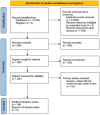Interdependence of Nutrition, Physical Activity, and Myopia
- PMID: 39408299
- PMCID: PMC11478443
- DOI: 10.3390/nu16193331
Interdependence of Nutrition, Physical Activity, and Myopia
Abstract
Background: Myopia (also known as nearsightedness), a prevalent refractive error, occurs when parallel rays of light converge in front of the retina, resulting in blurry distance vision. Recently, there has been a marked rise in myopia among the global population. The absence of effective methods of controlling the progression of this visual defect prompts the search for new preventive and therapeutic options. The impact of diet and lifestyle on the progression of myopia is still not fully understood. Therefore, our aim was to examine how these factors might affect the advancement of myopia, based on the existing literature. Methods: This manuscript was prepared through an extensive literature review conducted from June 2022 to September 2024. We searched for pertinent research articles using reputable databases, including PubMed, Scopus, and Web of Science. We included all types of publications, with a special focus on the newest ones. Results: Despite far-reaching examination, the relationship between these factors and myopia control remains inconclusive with varying degrees of evidence supporting their roles. Conclusions: However, promoting a healthy lifestyle, particularly increasing physical activity and outdoor time, is essential. Additionally, emerging research suggests that maintaining a balanced diet is important due to the potential impact of certain nutrients on myopia development. Ophthalmologists should also guide parents on the alternative correction methods beyond single vision glasses, especially for rapidly progressing cases. With the rising prevalence of myopia in children, further research is necessary.
Keywords: diet; lifestyle; myopia; myopia complications; myopia prevention.
Conflict of interest statement
The authors declare no conflicts of interest.
Figures



Similar articles
-
Phakic intraocular lenses for the treatment of refractive errors: an evidence-based analysis.Ont Health Technol Assess Ser. 2009;9(14):1-120. Epub 2009 Oct 1. Ont Health Technol Assess Ser. 2009. PMID: 23074518 Free PMC article.
-
Folic acid supplementation and malaria susceptibility and severity among people taking antifolate antimalarial drugs in endemic areas.Cochrane Database Syst Rev. 2022 Feb 1;2(2022):CD014217. doi: 10.1002/14651858.CD014217. Cochrane Database Syst Rev. 2022. PMID: 36321557 Free PMC article.
-
Interventions to slow progression of myopia in children.Cochrane Database Syst Rev. 2011 Dec 7;(12):CD004916. doi: 10.1002/14651858.CD004916.pub3. Cochrane Database Syst Rev. 2011. Update in: Cochrane Database Syst Rev. 2020 Jan 13;1:CD004916. doi: 10.1002/14651858.CD004916.pub4. PMID: 22161388 Free PMC article. Updated. Review.
-
Routine eye examinations for persons 20-64 years of age: an evidence-based analysis.Ont Health Technol Assess Ser. 2006;6(15):1-81. Epub 2006 Jul 1. Ont Health Technol Assess Ser. 2006. PMID: 23074485 Free PMC article.
-
Myopia Control: A Review.Eye Contact Lens. 2016 Jan;42(1):3-8. doi: 10.1097/ICL.0000000000000207. Eye Contact Lens. 2016. PMID: 26513719 Review.
References
-
- Fan Q., Verhoeven V.J.M., Wojciechowski R., Barathi V.A., Hysi P.G., Guggenheim J.A., Höhn R., Vitart V., Khawaja A.P., Yamashiro K., et al. Meta-Analysis of Gene-Environment-Wide Association Scans Accounting for Education Level Identifies Additional Loci for Refractive Error. Nat. Commun. 2016;7:11008. doi: 10.1038/ncomms11008. - DOI - PMC - PubMed
Publication types
MeSH terms
Grants and funding
LinkOut - more resources
Full Text Sources
Medical

